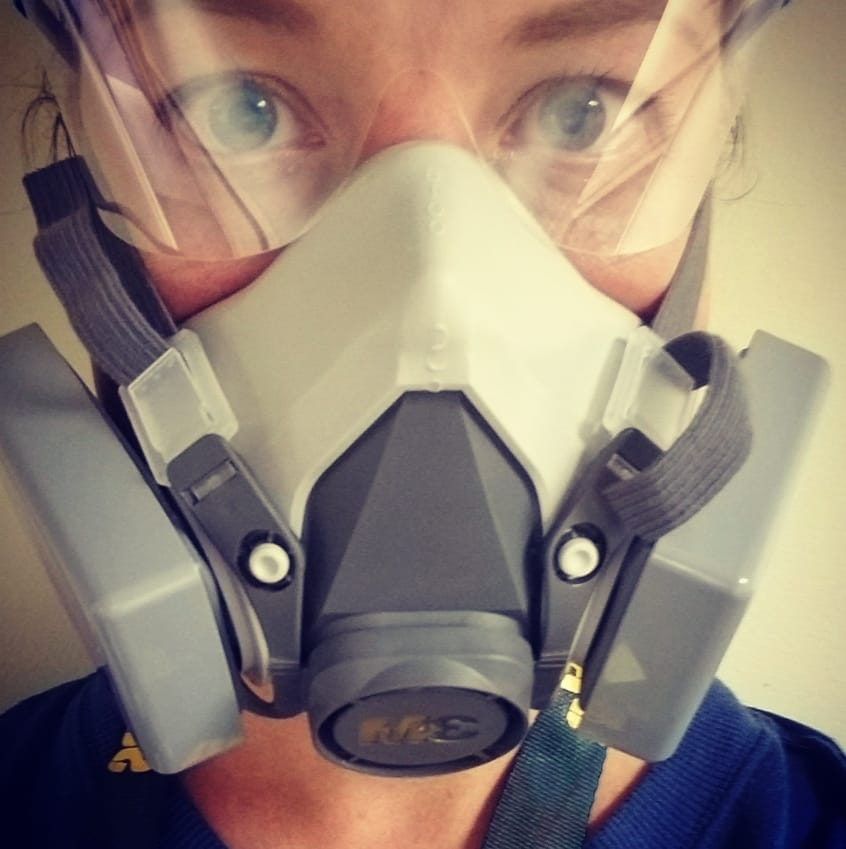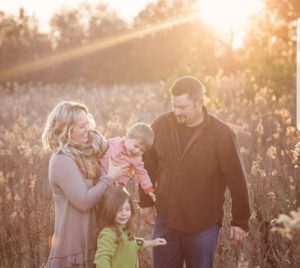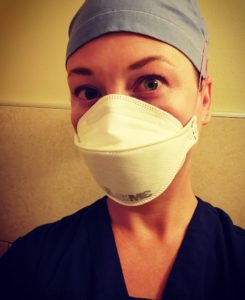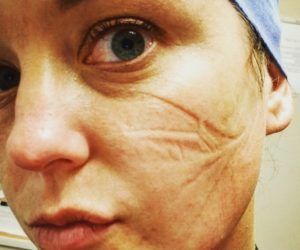
“I was told that I shouldn’t post pictures of myself in my respirator close up because it’s ‘scary’,” says Amanda, an ICU nurse currently working in a COVID-19 unit in St. Paul, Minnesota. “It should make you uncomfortable,” she states. “IT IS UNCOMFORTABLE. Know what else is uncomfortable to see? Whole units of people with the same diagnosis.”
Amanda felt she had to respond after being criticized for sharing a photo of herself in the reusable respirator she wears to work. “This is what I see when I look in the mirror at work. This is what my patients see,” she says. These patients are huffing and puffing and miserable, she adds. They are scared and withdrawn. Amanda does everything she can to comfort and encourage them.
 Wearing that “scary” looking respirator helps make her life less scary. She is worried about putting her family at risk. At home she has a seven-year-old and a four-year-old, and a husband who recently recovered from cancer.
Wearing that “scary” looking respirator helps make her life less scary. She is worried about putting her family at risk. At home she has a seven-year-old and a four-year-old, and a husband who recently recovered from cancer.
Echoes from the past
Amanda has experience working with patients with respiratory issues, and she worked during the H1N1 outbreak about a decade ago. “It was similar to the pandemic now – it was taking down people I didn’t think it would take down. And the general population didn’t see its severity.”
One case that vividly stands out during the H1N1 outbreak was a 26-year-old patient – the same age as Amanda at the time – who needed to be placed on a ventilator and deteriorated quickly. “I remember conversations with the patient and concerns about someone caring for their mom. The patient passed 48 hours later. It still sits with me more than 10 years later”
“There are a lot of echoes of that with COVID,” she adds. “This virus has impacted such a wide range of people from someone older with various comorbidities to a healthy young person – it doesn’t discriminate, and the long-term effects can be significant.”
And when people don’t see the severity of illness firsthand, like she does, they may not take it as seriously. “It’s hard when you hear people calling the pandemic fake or not severe,” Amanda says. “People might make me a cake to thank me for my work, but then they don’t wear a mask when they go out in public. I’d like to see more action from people focused on protecting each other instead of accolades.”
Making the switch from N95 disposable respirators to reusable respirators
 Amanda is a third-generation nurse and says it’s a calling for her. She volunteers to work in the COVID-19 ICU, where she’s been caring for patients since March. She says the unit is very isolated from the rest of the hospital and she and the rest of the staff work together as a cohesive team. “It’s a unique feeling to enter the unit,” she says. “You wear one respirator to enter the hospital, another to walk through the hospital, and then you change into another respirator as you enter the COVID-19 unit. We have negative air flow, there are no visitors and once you enter, you stay.”
Amanda is a third-generation nurse and says it’s a calling for her. She volunteers to work in the COVID-19 ICU, where she’s been caring for patients since March. She says the unit is very isolated from the rest of the hospital and she and the rest of the staff work together as a cohesive team. “It’s a unique feeling to enter the unit,” she says. “You wear one respirator to enter the hospital, another to walk through the hospital, and then you change into another respirator as you enter the COVID-19 unit. We have negative air flow, there are no visitors and once you enter, you stay.”
The hospital where Amanda works had initially told staff to reuse their N95 respirators five times before discarding them. Then, she and her coworkers got an email telling them they would get fit tested for a different type of respirator.
 “Initially, I felt fearful of switching,” she says. But the reusable respirator she was assigned turned out to be a welcome change. “It’s meant to be reused, so I feel more secure and that gives me an added sense of peace. And with that sense of peace, I feel more mentally clear – I can breathe easy.” She adds that if she didn’t have one of these, she’d would still be relying on a continuing supply of N95 disposable respirators. She says after wearing the reusable respirator for 12-hour plus shifts, she is much happier with the comfort and feeling of safety. While Amanda acknowledges reusable respirators may not be the ideal solution for every unit in the hospital, she recommends at least considering trying it out. “I would not want to return to using an N95 after this,” she says.
“Initially, I felt fearful of switching,” she says. But the reusable respirator she was assigned turned out to be a welcome change. “It’s meant to be reused, so I feel more secure and that gives me an added sense of peace. And with that sense of peace, I feel more mentally clear – I can breathe easy.” She adds that if she didn’t have one of these, she’d would still be relying on a continuing supply of N95 disposable respirators. She says after wearing the reusable respirator for 12-hour plus shifts, she is much happier with the comfort and feeling of safety. While Amanda acknowledges reusable respirators may not be the ideal solution for every unit in the hospital, she recommends at least considering trying it out. “I would not want to return to using an N95 after this,” she says.
Heroes on the front lines
When people call Amanda and her fellow healthcare workers heroes for working with COVID-19 patients, she feels a mix of emotions. “I’m proud of what we do,” she says. “There are many professions where you do what you are trained to do without thinking of danger, like the people who ran into the buildings on September 11.” She adds that while she still has tough days, she knows she can feel good when she goes home at the end of her shift knowing that she gave it her all.
